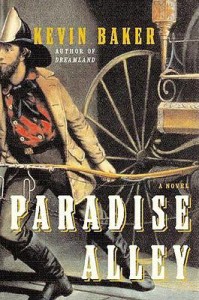Perennial
2002
 Paradise Alley is an epic novel tracing the events of the days of rioting in New York City in July of 1863. It follows a number of characters—refugees from the Irish potato famine, a escaped slave, a newspaper reporter and a child prostitute, to name but a few. Think of Martin Scorsese’s film, Gangs of New York crossed with the Reign of Terror in the French Revolution—only more violent and barbaric.
Paradise Alley is an epic novel tracing the events of the days of rioting in New York City in July of 1863. It follows a number of characters—refugees from the Irish potato famine, a escaped slave, a newspaper reporter and a child prostitute, to name but a few. Think of Martin Scorsese’s film, Gangs of New York crossed with the Reign of Terror in the French Revolution—only more violent and barbaric.
Each chapter tells the story from the point of view of one of the characters, the unfolding of the riot itself, but also going back to the hell of the potato famine which sent some many thousands of Irish to New York, and to the enslavement of Africans in the Southern States.
When President Lincoln called for a draft in New York City to raise troops for the Civil War they said that any man could pay a fee of $300 to have a substitute go in his place. The working class mob of mostly Irish immigrants quickly took offence at this. A black slave cost $1,000 but—by their logic—they were only worth $300? The blacks were not being called up to fight in the war to free their own but white men were. The fact that the escaped slaves wanted to fight but were not allowed to join the military at that time was not a detail the rioters wished to dwell on.
The novel follows the equivalent of the Roman mob as they loot, burn, torture and murder anyone they think has it coming. Old scores are settled and any black or mixed race person, man—woman or child—who could not escape was savagely mutilated and murdered by the people who were their grudging neighbours the day before.
The main strand of the story tells of Billy Dove, an escaped slave and his white, Irish wife, Ruth. Billy works in an orphanage for negro children. Having escaped slavery and come to the north, Billy found that no one would employ him as a shipbuilder or in any kind of manly work. The racism among the white working classes at the time was such that all the men would immediately walk off the job if their bosses employed a black man to work along side them. So he found work as a child minder, a job that did not pay very well, nor did it satisfy his yearning to work with his hands and build things. After struggling for years to survive the city’s bigotry and bring up their children, the story begins when they hear that Ruth’s former lover and captor—a crazed sadist—is back in town and no doubt out for vengeance. As they plan to flee from him the riot erupts and the two events combine to test the pair beyond the point where even slavey and famine could not. We follow Billy as he leads the orphans to escape from a mob intent on killing them, while Ruth tries to protect her children from the rioters outside her door.
Through page after page we see the circumstances in which the riot happened. We see stories of unbelievable savagery and cruelty as the mob go from one atrocity to the next. But there are also stories of bravery, love, courage and ingenuity. People are pushed to horrendous straits in their attempts to stay alive and save the people they love.
The thing that makes this book so harrowing to read is that it is all based on facts—it really did happen. For four days New York City descended into a savagery with few counterparts in history.
Kevin Baker’s writing is engaging and clear, never sentimental or sensationalistic. You feel for the characters and despair at the cruelty meted out to them.
Not a happy read but a compelling one. A fictional history, if you will. I highly recommend it.

